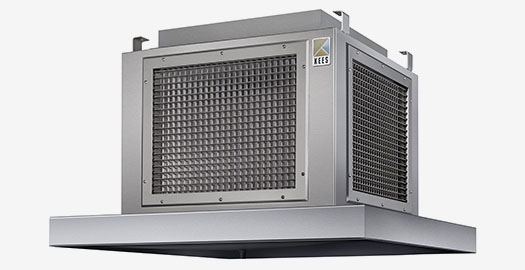5 Tips to Get the Drop Box You Need
May 21, 2021
As more and more consumers shop online, large distribution centers are popping up across the country to satisfy the demand. In addition, food production facilities and manufacturing plants are also dominating construction trends. These enormous spaces require drop box diffusers, an efficient way to distribute air without the need for expensive ductwork.
As you might imagine, there is a lot to consider when choosing the right product. Laura Self, KEES engineer and drop box expert, shares five tips to ensure you get just what you need.

1. Start with what matters most: CFM
It’s important to match the drop box dimensions with the required air flow. Improperly sized drop boxes can result in performance issues such as poor discharge velocity, high pressure drops or excessive noise. Also, make sure to check both the schedule and plans to find the CFM requirements as sometimes details are spread across both.
2. Know where the box will be located
This essential information will have a big impact on the material used for product construction. For example, a drop box located in dry storage (e.g. warehouse) would typically use galvanized steel or aluminum. In wet environments, stainless steel or aluminum construction may be preferred. Stainless steel is the best material for food processing where harsh chemicals are often used to clean equipment.
3. Select the best blow pattern
We know it’s expensive to condition air, so make sure it gets to the right place by choosing from 2, 3, 4, or 6-way blow options. Use 2-way for corner locations and 3-way for wall locations. 4-way and 6-way patterns provide 360-degree air distribution at the center of an open space. Any of these profiles can be further configured with the addition of volume dampers. These dampers allow the precise amount of air to be delivered through each grille or drum louver.
4. Choose between grilles and drum louvers
Throw: The size of the building and the number/location of the rooftop units can help to determine what’s needed to properly distribute air through the building. Drum louvers throw air farther (i.e. cover more area), while grilles are often used for more localized air distribution or for their lower pressure drops.
Profile: Drum louvers have a lower profile than grilles and are better for any facility with clearance issues or where inventory is stacked high. This includes production environments with large machinery or storage environments where space to house inventory is at a premium.
5. Consider special construction options
Continuously welded seams protect the insulation in double-walled construction from condensation or wash down cleaning fluids. Additionally, consider including a drain fitting or a separate drain pan with fitting to manage these liquids. In a refrigerated environment, consider a heated drain pan to reduce the likelihood of icing and water overflow. These safety measures will help prevent contamination of your work area and product.
Finally, mounting can be tricky as every installation is unique. Consider the location of structural anchor points and if you need hanger brackets for suspension. If standard brackets and placement don’t meet your exacting requirements, tell us what you need.
If you have any questions about a project involving drop box diffusers, please contact Laura.
